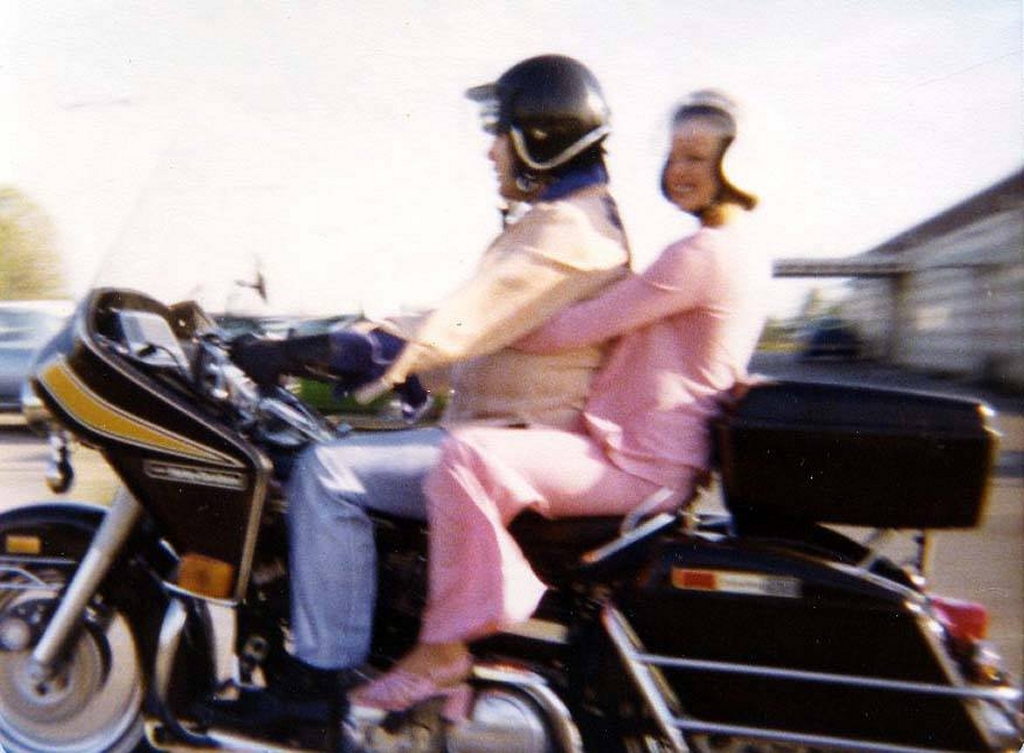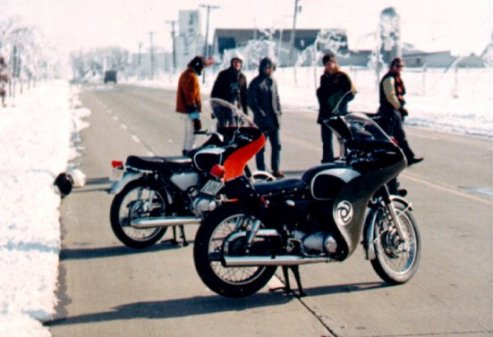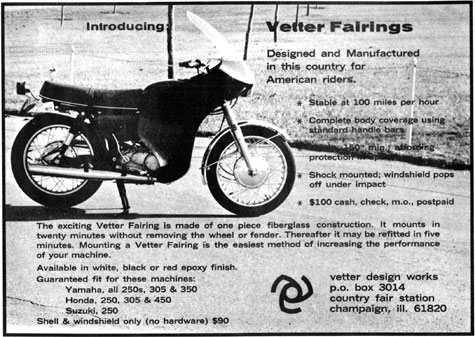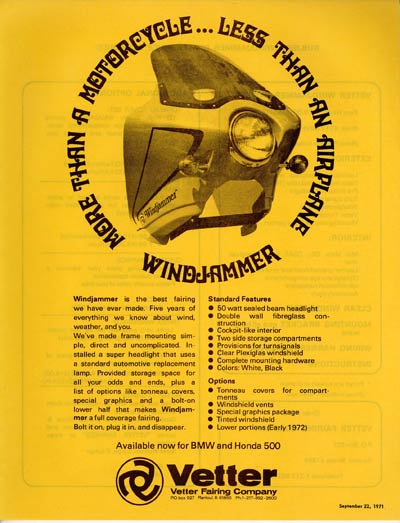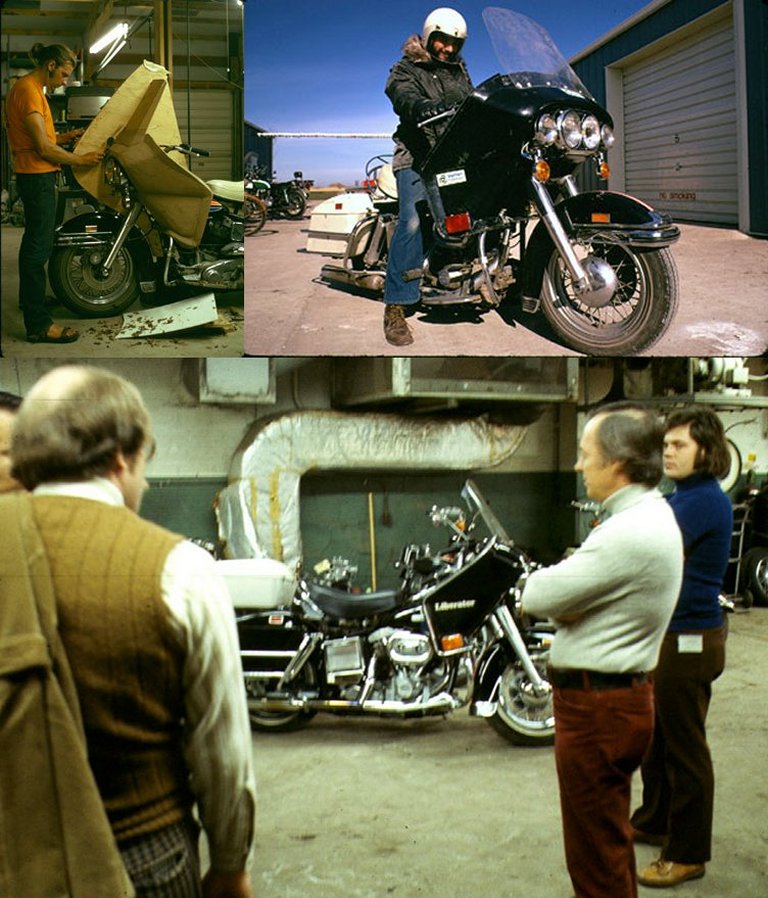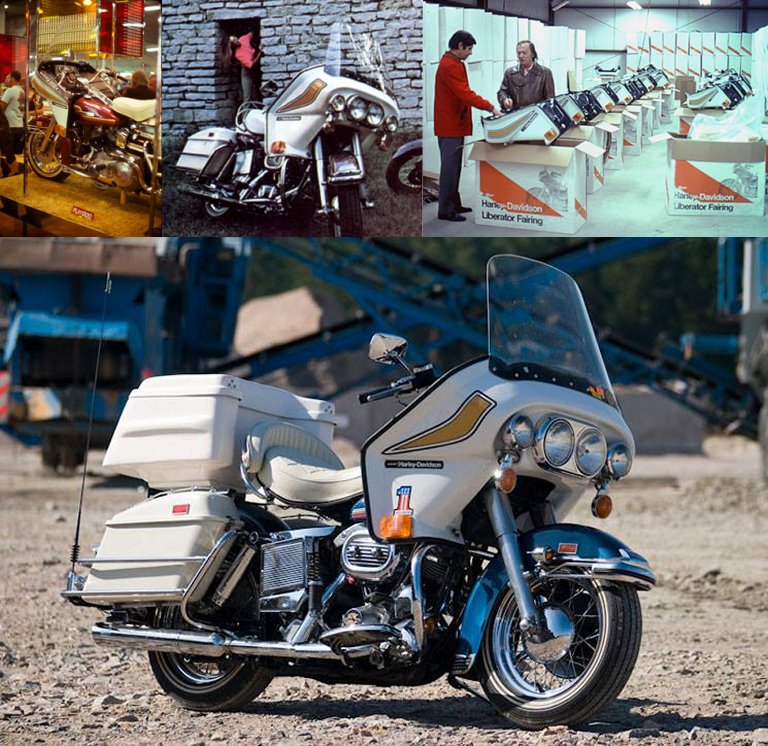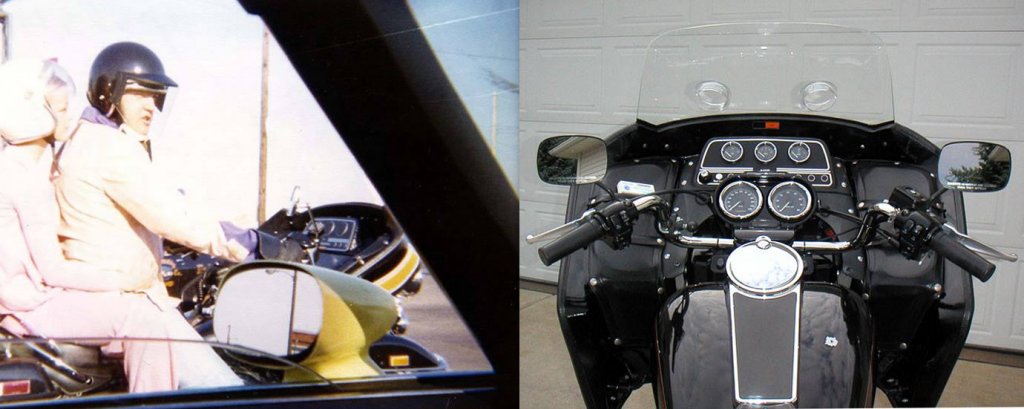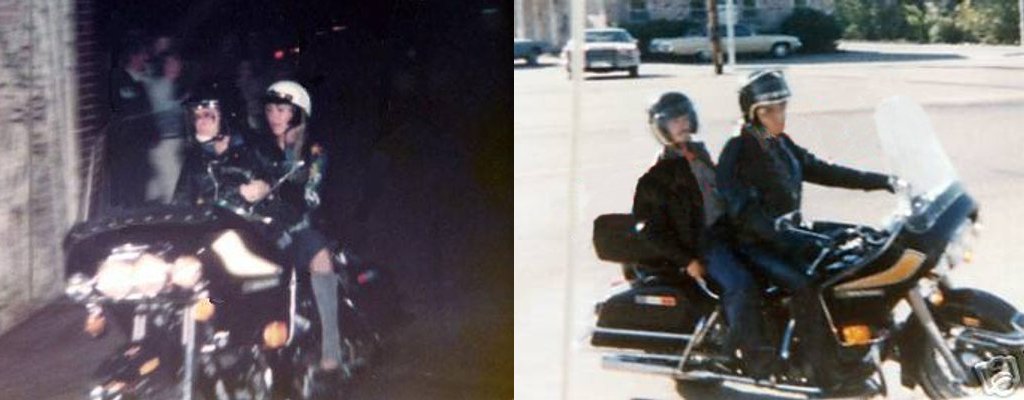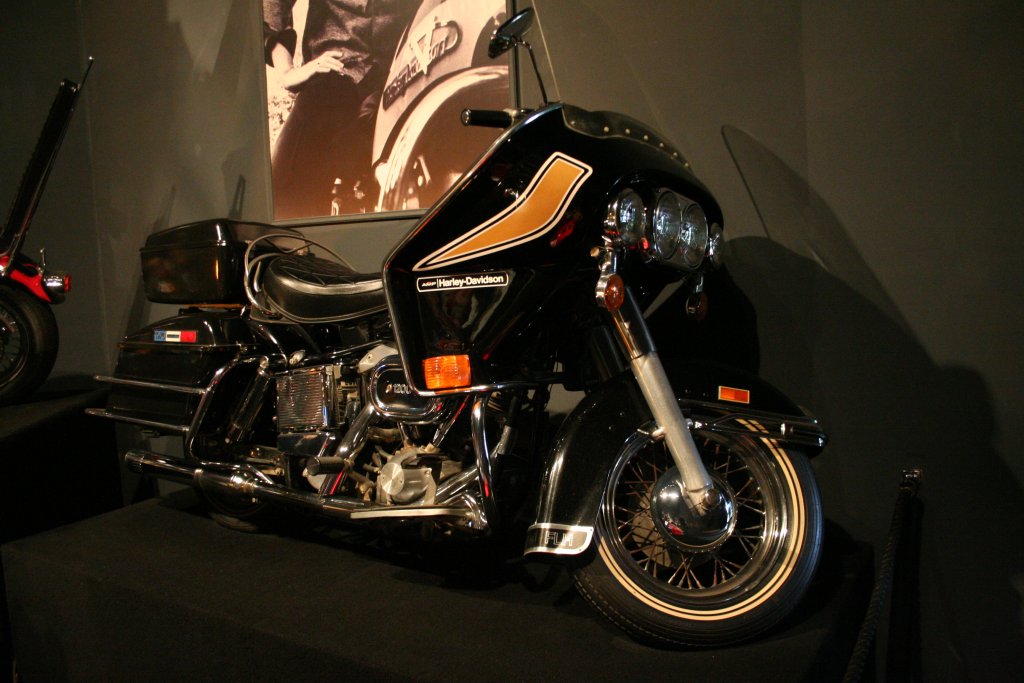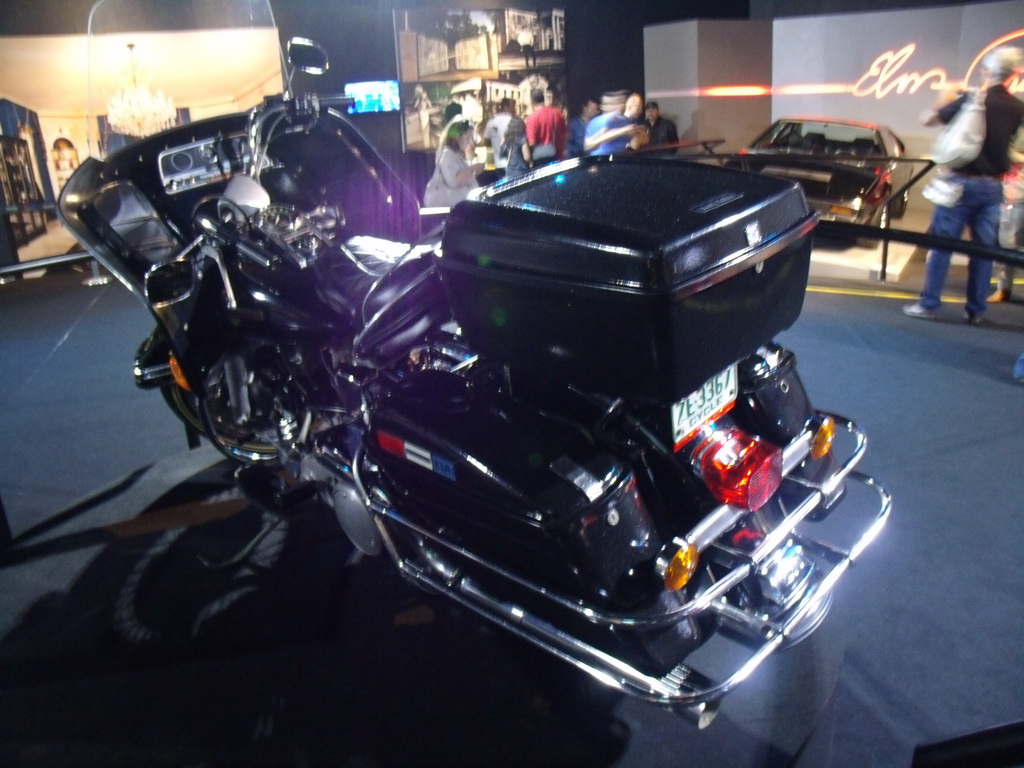 |
1976 Harley-Davidson FLH
Electra-Glide Vetter Liberator
In March of 1976 Elvis bought another Harley-Davidson FLH 1200 Electra-Glide. It was the first of several he bought that year but the only one we've seen pictures of him riding. It was a black 1976 Liberator model, named that because of the type of fairing it came equipped with, though the bike itself was basically a black metallic "Liberty Edition". Up until then Elvis didn't seem partial to fairings but unlike the fork mounted hollow "batwing" fairing originally designed and offered by Harley-Davidson, the Liberator, designed and built by the Vetter Fairing Company, was mounted to the frame and offered improved aerodynamics and handling.
Craig Vetter started designing and building frame mounted fairings in October of 1966 in the living room of his rented home in Champaign, IL. His first was for his Yamaha 305 and then he began showing his friends how to build them from the molds. By February of 1967 he had built around 10 and took out his first ad in the March 1967 issue of Cycle World magazine.1
By 1970 he offered and was building five different versions specifically designed to fit a particular brand and model motorcycle (basically Japanese, BMW, BSA and Triumphs). He found it difficult to keep the molds in good shape and noted that it was impossible for a dealer to stock a particular fairing a customer might want.1
In the winter of 1970 he began designing a universal fairing that would fit any motorcycle. Noticing the top portions were all pretty much the same he cut the bottom off one of his fairings designed for a Honda 750, put it on a Kawasaki 500, then Honda, BMW and Suzuki. It fit and the ride was quieter. This was the beginning of what would become the Windjammer and it immediately obsolesced his other designs and interest in them. Staring in 1971 they produced over 400,000 in six variations over the next eight years.1
In 1973 Craig contacted Harley-Davidson to inquire about building a frame mounted fairing for the FLH. Naturally, Harley was interested so they began a design. Craig said he had the name for it already, the "Liberator," like the WWII B-24 bomber his father had been a crew chief on during WW II. He liked the idea of making a "big bomber of a fairing."1
Noting that the FLH was the definitive cross - country cruiser of America, they wanted this fairing to offer the most protection possible. They mounted dual sealed beam headlights in the fairing along with the auxiliary lamps and turn signals. Getting all those Harley lights in there was a challenge. I hoped to be able to put a clear, rounded cover over the front, but the laws at that time would not allow it. On the inside were two large storage compartments and instrumentation. The Liberator made its debut in Las Vegas in 1975.1 We don't know if Elvis saw one there first.
The Liberator and the Vetter Fairing Company were short lived. Less than about 5,000 ever made it to market. Most were lost along with the molds in a fire at the company in January of 1977. In November of 1978 Craig sold the company and by 1983 it had gone bankrupt.
Like most of the FLHs produced in 1976 the saddle bags had Red, White and Blue reflectors, acknowledging the nation's 200th birthday, and once again the Electra-Glide name was back on the bike (on the reflector). In October of 1999 Graceland did some housecleaning in their archives and held a big auction at the MGM Grand in Las Vegas. One of the items they sold was an AMF Owner ID for a 1976 Harley. In the catalog they mis-described it as being for a red, white and blue bicentennial model. Harley-Davidson never made one as described, offering instead that year the "Liberty Edition," a full dressed black FLH with "batwing" fairing emblazoned with Eagle decals, a theme that, combined with their shield, is still used today.
The ID and corresponding VIN are quite likely the card that came with Elvis' Liberator. The number identifies it as an FLH with a sequence number of 25,334 made for the model year 1976. It bears a delivery date of March 25 and the earliest pictures of him riding the Liberator are from that April.
The fairings bore the "AMF Harley-Davidson" name and though bikes of that era are often frowned upon, that opinion is not completely deserving. To give credit to AMF, if they hadn't come along in 1969 and taken H-D in tow, the Motor Company might only be a golf-cart manufacturer today.* In 1969, sales revenues of all products were just over $49 million. When the turnover took place in 1981, sales had risen to $300 million.2 In 1979 Harley-Davidson introduced the Tour-Glide which had a larger frame and engine and their own frame mounted fairing. Today, the Harley-Davidson Road-Glide carries on the frame mounted fairing tradition.
Elvis' 1976 Harley-Davidson FLH 1200 Liberator remains part of the collection at Graceland, and on occasion goes on tour. page added October 5, 2015 Special thanks to FECC's DJC for identification of Tori Petty as passenger in April 1972 photos. 1 according to or quoted from Craig
Vetter at Vetter
Classic American Design * Elvis had at least two golf carts that were made by Harley-Davidson and are also still part of Graceland's collection.
|
||
|
All photos on this site (that we didn't borrow) unless otherwise indicated are the property of either Scotty Moore or James V. Roy and unauthorized use or reproduction is prohibited. |
